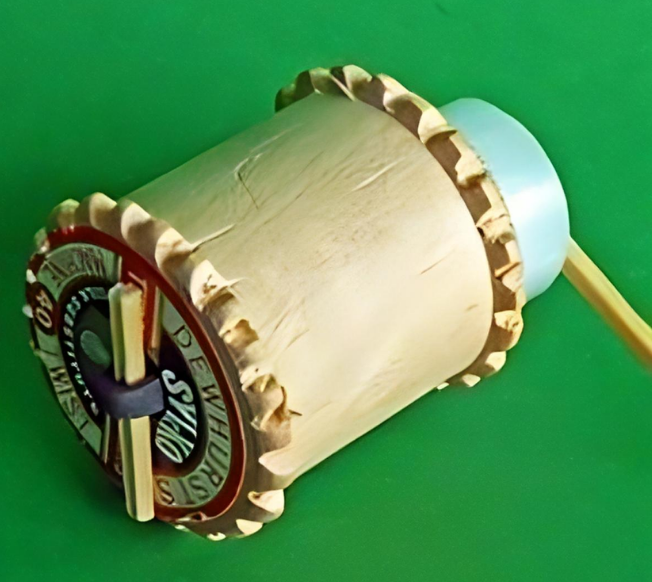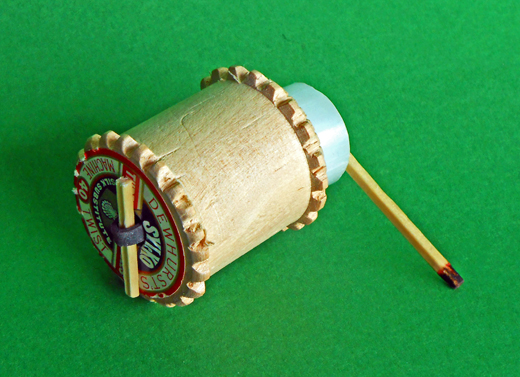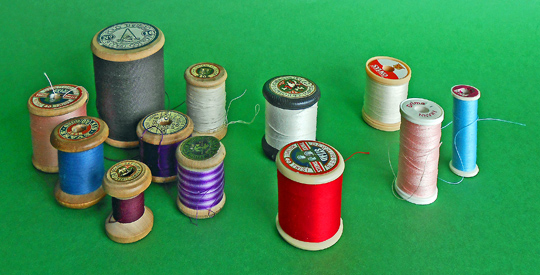In a world long before computer games and high-tech toys, children had to get creative to entertain themselves. One of the most beloved homemade toys from this era was the cotton-reel tank. Made from everyday household items like wooden cotton reels, elastic bands, matchsticks, and a bit of wax, these simple toys brought hours of joy to children. With ingenuity and imagination, kids turned these humble materials into miniature, self-propelled “tanks” that could race across floors and even climb small obstacles.

This article explores the history, design, and enduring charm of the cotton-reel tank, offering a glimpse into a time when toys were not mass-produced, but crafted with care and creativity.
What Is a Cotton-Reel Tank?
A cotton-reel tank is a simple, self-propelled toy made from a wooden cotton reel, a rubber band, a matchstick, and a slice of wax from a candle. By winding the elastic band, children could make the tank “crawl” along on its own, providing endless amusement. The reel itself acted as the body and wheels, while the matchstick and rubber band provided the propulsion.
This toy was particularly popular in the mid-20th century, but its origins are likely older, dating back to when wooden cotton reels were a common household item. It was a testament to how resourceful children could be, turning everyday items into playthings full of potential.
The Technical Build: How to Make a Cotton-Reel Tank
Making a cotton-reel tank was as much an exercise in creativity as it was in engineering. The materials were simple, but the design was clever. Here’s how the process worked:
- Materials Needed: A wooden cotton reel, an elastic band, a piece of wax candle, and two matchsticks.
- Creating the Propulsion System: A disc of wax was sliced from the candle, and a small hole was made through its center. An elastic band was threaded through this hole and then pulled through the hollow center of the cotton reel.
- Securing the Mechanism: One end of the elastic band was secured by a matchstick, which was pushed through the loop. The other end of the elastic was secured by threading it through a second matchstick or a small nail, which acted as an anchor. This matchstick would be wound tightly to store potential energy in the elastic band.
- Winding and Releasing: Once the matchstick was wound and the tank placed on a flat surface, the tension in the elastic would unwind, turning the reel and propelling the “tank” forward.
This simple mechanism made it a self-propelled toy, and the appeal lay in both its ease of assembly and the challenge of getting it to move just right.
Design Innovations and Enhancements
Children rarely stopped at the basic design; they often added their own creative modifications to improve performance or aesthetics. The most common upgrade was to notch the edges of the cotton reel, which helped the tank get better traction on rough surfaces. Some children extended the matchstick that touched the ground, creating better contact for movement, and others experimented with glue or tiny nails to hold the matchstick in place more securely.
Of course, a cotton-reel tank wasn’t complete without a coat of paint. Many children decorated their tanks with colorful designs, adding to the excitement and personalizing their toy in the process.
These little improvements turned a basic toy into something special, encouraging children to think like engineers, experimenting with what worked and what didn’t. The sense of accomplishment when their tank moved across the floor or climbed over an obstacle was one of the simple joys of childhood.

Origins of the Cotton-Reel Tank: Inspired by Real Tanks?
One question that often arises is whether these toys were inspired by the real-life tanks of World War I. It’s certainly possible. Tanks were first introduced in battle in 1916, and their clunky, crawling movements were similar to the way a cotton-reel tank would roll across the floor. By the time of World War II, when cotton-reel tanks were commonly played with, tanks were an integral part of military strategy, and it’s easy to see how children’s toys could have been influenced by the machines of the battlefield.
However, the exact origin of the cotton-reel tank is unclear. While some speculate that it was a direct imitation of military vehicles, it may simply have been a case of creative play using whatever was at hand. Regardless of its roots, the cotton-reel tank became a beloved toy during the mid-20th century, particularly during wartime when children were keen to mimic soldiers and battle scenes.
The Decline of the Cotton-Reel Tank
As with many homemade toys, the cotton-reel tank began to disappear from playrooms as store-bought toys became more widely available. By the 1960s, families had more disposable income, and children had access to commercially produced toys that were more sophisticated than homemade ones. With the rise of television and, later, video games, the need for DIY entertainment faded.
Another factor in the demise of the cotton-reel tank was the evolution of cotton reels themselves. Once made of wood, which was perfect for toy-making, cotton reels began to be produced from plastic. These plastic reels were less durable and not as easy to manipulate into toy tanks. As the plastic reels changed shape and size, the basic design of the cotton-reel tank became more difficult to execute.

The Legacy of Cotton-Reel Tanks
While the cotton-reel tank is now largely a relic of the past, it remains a fond memory for many who grew up making them. These simple toys were more than just a way to pass the time—they represented a creative, hands-on approach to entertainment that is often missing in today’s world of instant gratification.
The skills learned from making cotton-reel tanks—problem-solving, patience, and the satisfaction of crafting something from nothing—are timeless. These toys encouraged children to use their imagination and resourcefulness, qualities that are still valuable today.
Conclusion: A Simple Toy with Timeless Appeal
The cotton-reel tank is a reminder of a bygone era when children’s entertainment came from what they could build with their own hands. Made from everyday materials like wooden reels, wax, and elastic bands, these self-propelled toys provided hours of amusement. Though their popularity has faded, the ingenuity behind them continues to inspire a sense of nostalgia and appreciation for the art of simple, handmade toys.
In a world filled with digital distractions, the cotton-reel tank stands as a charming example of creativity, resourcefulness, and the joy of making something with your own hands. For those who remember building them, the sound of a cotton-reel tank crawling across the floor brings back memories of a time when fun was something you created, not something you downloaded.


